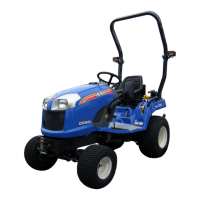Why are the exhaust fumes from my Iseki TXG237 too black?
- KKimberly JohnsonSep 8, 2025
If the exhaust fumes from your Iseki Tractor are too black, replace the fuel with a better grade. If the problem persists, consult your dealer.

Why are the exhaust fumes from my Iseki TXG237 too black?
If the exhaust fumes from your Iseki Tractor are too black, replace the fuel with a better grade. If the problem persists, consult your dealer.
How to fix Iseki Tractor brakes that don't work well?
If the brakes on your Iseki Tractor do not work well, adjust the free play. If the problem persists, consult your dealer.
Why doesn't the brake pedal return smoothly on my Iseki TXG237 Tractor?
If the brake pedal on your Iseki Tractor does not return smoothly, replace the broken spring or remove rust and lubricate the pedal mechanism.
How to repair leaking piping on Iseki TXG237?
If there is leaking piping on your Iseki Tractor, retighten the connections or replace the pipes and o-rings.
Explains safety symbols (Danger, Warning, Caution) and general precautions for safe operation.
Emphasizes operator familiarity, prohibited users, and the importance of protective gear.
Safety precautions and procedures for handling and maintaining the tractor's battery.
Detailed description of gauges, switches, and indicator lights on the instrument panel.
Explanation of the indicator lights on the dashboard, including warning and status lights.
Description of the brake pedal's function in controlling the tractor's braking system.
Operation and adjustment of the throttle lever for controlling engine speed.
Operation of the range gearshift lever for selecting different speed ranges.
How the hydrostatic control pedals manage forward and reverse travel speed.
Operation of the PTO clutch lever for engaging and disengaging power take-off systems.
Adjusting the three-point hitch height using the control lever for implement positioning.
Essential procedures for breaking in the tractor and engine for optimal performance and longevity.
Daily checks before starting the tractor to ensure safe and proper operation.
Comprehensive step-by-step guide for starting the tractor's engine.
How the hydrostatic transmission enables variable speed control in forward and reverse.
Correct procedures for stopping the tractor, including parking and engine shutdown.
Critical safety warnings and operational points for the Power Take-Off system.
Details on the rear PTO shaft, including speed and connection requirements.
How to operate the PTO clutch lever and selector levers for rear and mid PTOs.
Adjusting the three-point hitch height using the control lever for implement positioning.
Step-by-step guide for safely attaching implements to the tractor's three-point hitch.
Procedures for safely detaching implements from the tractor's hitch.
Information and safety warnings related to the Roll Over Protective Structure (ROPS) and seat belts.
A comprehensive schedule outlining required maintenance tasks based on operating hours.
Steps for checking and replacing transmission oil and associated filters.
Instructions for checking and changing the oil in the front axle and differential units.
Details on the cooling system, including coolant level checks and maintenance procedures.
Procedures for adjusting brake pedal free-play and ensuring proper brake balance.
Common engine problems, their potential causes, and recommended remedies.
Troubleshooting guide for common brake system problems, including causes and remedies.
Troubleshooting guide for hydraulic system issues, including oil pressure, leaks, and hitch problems.
Troubleshooting common problems related to the steering system, such as stiffness or excessive play.
Troubleshooting common electrical system faults, including battery, lamps, and function failures.
Instructions for assembling the tractor components after it has been shipped partially disassembled.
A comprehensive checklist for pre-delivery inspections and final checks before customer delivery.